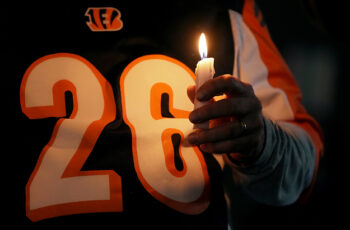What is commotio cordis?
Commotio cordis occurs when a blow, typically from fast-flying objects like baseballs and hockey pucks, to a specific part of the chest happens during a portion of the cardiac cycle that disrupts the heart’s electrical activity. Strikes to the chest during contact sports like karate and football can also trigger the event.
The result is a potentially deadly arrhythmia, or irregular heartbeat, that leads to cardiac arrest. (Cardiac arrest is not the same as a heart attack, which occurs when blood flow to the heart is blocked.) The arrhythmia involved is most often ventricular fibrillation, which is when the lower chambers of the heart contract rapidly, preventing the heart from pumping blood to the rest of the body. (In fact, a study on an anesthetized pig helped researchers learn this.)
Similar to what happened to Hamlin, people experiencing commotio cordis don’t always lose consciousness right away. About 20% of people may be able to continue playing their sport and even talk for a few seconds before collapsing.
It occurs most frequently in male teens playing competitive sports (average age of 15) and is considered to be the second-leading cause of sudden death in young athletes after hypertrophic cardiomyopathy, a disease that causes the heart muscles to thicken, making it harder to pump blood. Data also shows that cases are rising. However, experts believe the increase in diagnoses is due to a greater awareness of commotio cordis that has better prepared people to treat it.
Published research shows that commotio cordis has been reported among players of many sports, including baseball, lacrosse, softball, martial arts, rugby, football, cricket, and hockey — despite the use of protective equipment like chest protectors or softer balls, although the risk is likely lower with these precautions in place.
Still, it’s considered an extremely rare event.
“I’ve been watching football my whole life and I’ve never seen this happen. This is so incredibly rare, it’s like winning the Powerball or getting hit by lightning twice,” said Dr. Grant Simons, a cardiac electrophysiologist and chief of heart rhythm services at Hackensack University Medical Center, who watched the Buffalo Bills game live. “There’s about a 30th of a second that the heart is even vulnerable to this. So not only does the hit have to be in the right spot on the heart and the right amount of force, it also has to be perfectly timed.”
The most recent study published from the US National Registry of Sudden Death in Athletes in 2016 found that of 2,192 deaths, 58 athletes experienced commotio cordis between 1980 and 2011. The event is reported up to 20 times a year, mostly in the US but in other countries as well.
The last high-profile case involved hockey player Chris Pronger, when a puck hit him on the left side of his chest during the Stanley Cup Playoffs in 1998, leaving him unconscious for about 20 seconds. Pronger returned to the ice four days later.
“Prayers that Damar Hamlin can have the same outcome that I was fortunate to have with my incident,” Pronger tweeted Jan. 3. “Our thoughts and prayers go out to Damar, his family, teammates and the greater NFL community during this incredibly scary time.”
How is commotio cordis treated?
Immediate treatment with CPR and an automated external defibrillator (AED) that delivers electrical shocks to the heart to restore its normal rhythm is absolutely necessary for survival after commotio cordis. Survival rates decline by 10% for every one-minute delay in getting shocked by an AED, according to the Korey Stringer Institute at the University of Connecticut.
Data from a national commotio cordis registry shows that survival rates have been increasing over the last 15 years, reaching nearly 60%. Researchers say greater access to AEDs and better resuscitation training have contributed to the improved survival rates.
It’s unclear whether Hamlin received AED treatment, but Simons said it’s likely given his heartbeat returned on the field. Unfortunately, not all people who are resuscitated after commotio cordis fully recover; some are left with brain injuries if treatment wasn’t initiated fast enough.
“Hopefully they shocked him within just a short period of time and were able to do effective compressions to keep his brain supplied with oxygen,” Simons said. “If both of those things are true, then you would hope and expect that he would make a full neurologic recovery and also a full cardiac recovery and not have any long-term functional effects on a part of his brain.”
Source: https://www.buzzfeed.com/katiecamero/commotio-cordis-damar-hamlin-what-to-know
